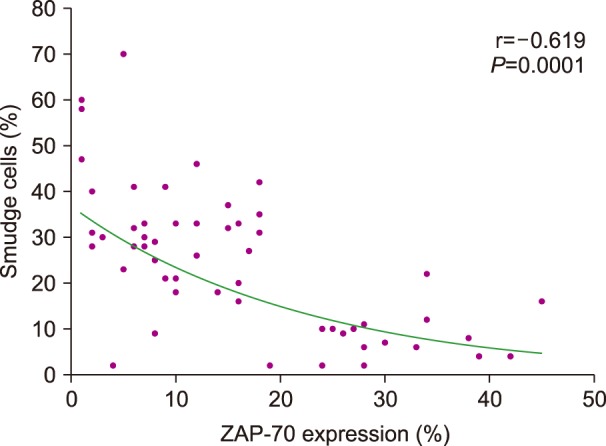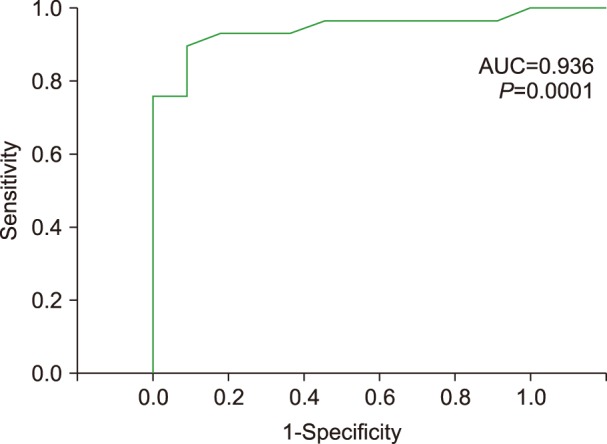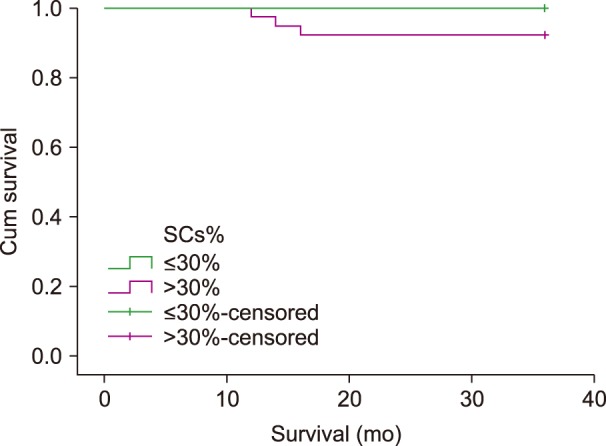Blood Res.
2018 Sep;53(3):218-222. 10.5045/br.2018.53.3.218.
Smudge cell percentage as a surrogate marker for ZAP-70 expression in patients with chronic lymphocytic leukemia
- Affiliations
-
- 1Department of Hematology, Faculty of Medicine and Health Sciences, University of Aden, Aden, Yemen. kahiry13@gmail.com
- 2Department of Medical Laboratory Technology, Pharos University in Alexandria, Alexandria, Egypt.
- 3Department of Hematology, Medical Research Institute, University of Alexandria, Alexandria, Egypt.
- KMID: 2429321
- DOI: http://doi.org/10.5045/br.2018.53.3.218
Abstract
- BACKGROUND
This study aimed to evaluate the prognostic value of smudge cell percentage as a surrogate marker for zeta-chain-associated protein kinase 70 (ZAP-70) expression in chronic lymphocytic leukemia (CLL) patients.
METHODS
Sixty three newly diagnosed CLL patients were investigated at the Hematology Department of the Medical Research Institute of Alexandria University with complete blood count, lactate dehydrogenase, β2 microglobulin levels, ZAP-70 expression, and estimation of the percentage of smudge cells.
RESULTS
The percentage of smudge cells ranged from 2 to 58% with a mean of 24.03±13.98%. Higher percentages of smudge cells (>30%) were statistically significantly associated with markers of better prognosis (negative ZAP-70, early-stage disease according to the Binet and Rai staging systems, as well as low and intermediate risk CLL prognostic index). The percentage of smudge cells showed significantly negative correlation with the ZAP-70 expression and higher area under the curve for prediction of ZAP-70 positivity with better survival for 36 months in patients with >30% smudge cells.
CONCLUSION
The percentage of smudge cells at presentation of newly diagnosed CLL patients could be used as a surrogate marker for ZAP-70 expression and an additional prognostic marker for disease progression.
Keyword
MeSH Terms
Figure
Reference
-
1. Montserrat E, Hillmen P. Postgraduate haematology. In : Hoffbrand AV, Higgs DR, Keeling DM, Mehta AB, editors. Chronic lymphocytic leukaemia and other B-cell disorders. 7th ed. Oxford, UK: Wiley Blackwell;2016. p. 500–523.2. Bennett JM, Catovsky D, Daniel MT, et al. Proposals for the classification of chronic (mature) B and T lymphoid leukaemias. French-American-British (FAB) Cooperative Group. J Clin Pathol. 1989; 42:567–584. PMID: 2738163.
Article3. McMullin MF. 70 years of the JCP-highly cited papers: Proposals for the classification of chronic (mature) B and T lymphoid leukaemias. J Clin Pathol. 2017; 70:909–910. PMID: 29070652.
Article4. Nosanchuk JS. The effect of smudge cells on leukocyte counting-are chamber counts necessary? Am J Clin Pathol. 1979; 71:161–166. PMID: 425933.5. Macdonald D, Richardson H, Raby A. Practice guidelines on the reporting of smudge cells in the white blood cell differential count. Arch Pathol Lab Med. 2003; 127:105. PMID: 12562274.
Article6. Hematology Committee, Quality Management Program-Laboratory Services. Good practice guidelines: reporting of smudge cells. Hematology morphology binder. Toronto, Canada: Hematology-Morphology Binder;2001.7. Johansson P, Eisele L, Klein-Hitpass L, et al. Percentage of smudge cells determined on routine blood smears is a novel prognostic factor in chronic lymphocytic leukemia. Leuk Res. 2010; 34:892–898. PMID: 20353875.
Article8. Binet JL, Auquier A, Dighiero G, et al. A new prognostic classification of chronic lymphocytic leukemia derived from a multivariate survival analysis. Cancer. 1981; 48:198–206. PMID: 7237385.
Article9. Rai KR, Sawitsky A, Cronkite EP, Chanana AD, Levy RN, Pasternack BS. Clinical staging of chronic lymphocytic leukemia. Blood. 1975; 46:219–234. PMID: 1139039.
Article10. Gentile M, Mauro FR, Rossi D, et al. Italian external and multicentric validation of the MD Anderson Cancer Center nomogram and prognostic index for chronic lymphocytic leukaemia patients: analysis of 1502 cases. Br J Haematol. 2014; 167:224–232. PMID: 25041609.
Article11. Preobrazhensky SN, Bahler DW. Optimization of flow cytometric measurement of ZAP-70 in chronic lymphocytic leukemia. Cytometry B Clin Cytom. 2008; 74:118–127. PMID: 17948236.
Article12. Matutes E, Owusu-Ankomah K, Morilla R, et al. The immunological profile of B-cell disorders and proposal of a scoring system for the diagnosis of CLL. Leukemia. 1994; 8:1640–1645. PMID: 7523797.13. Moreau EJ, Matutes E, A'Hern RP, et al. Improvement of the chronic lymphocytic leukemia scoring system with the monoclonal antibody SN8 (CD79b). Am J Clin Pathol. 1997; 108:378–382. PMID: 9322589.14. Nowakowski GS, Hoyer JD, Shanafelt TD, et al. Using smudge cells on routine blood smears to predict clinical outcome in chronic lymphocytic leukemia: a universally available prognostic test. Mayo Clin Proc. 2007; 82:449–453. PMID: 17418074.
Article15. Allison RW, Meinkoth JH. Hematology without the numbers: in-clinic blood film evaluation. Vet Clin North Am Small Anim Pract. 2007; 37:245–266. PMID: 17336674.
Article16. Johnston A, McFarlane A, Bourner G, Martin T, Padmore R. Distinguishing morphology of reactive versus abnormal neoplastic peripheral blood lymphocytosis. Challenges illustrated by two proficiency testing surveys. Int J Lab Hematol. 2016; 38:e41–e44. PMID: 26872147.
Article17. Palmer L, Briggs C, McFadden S, et al. ICSH recommendations for the standardization of nomenclature and grading of peripheral blood cell morphological features. Int J Lab Hematol. 2015; 37:287–303. PMID: 25728865.
Article18. Vives-Corrons JL, Briggs C, Simon-Lopez R, et al. Effect of EDTA-anticoagulated whole blood storage on cell morphology examination. A need for standardization. Int J Lab Hematol. 2014; 36:222–226. PMID: 24330572.
Article19. Jacob EA. Complete blood cell count and peripheral blood film, its significant in laboratory medicine: a review study. Am J Lab Med. 2016; 1:34–57.20. Nowakowski GS, Lee YK, Bone ND, et al. Proteomic analysis of chronic lymphocytic leukemia cells identifies vimentin as a novel prognostic factor for aggressive disease. Blood. 2005; 106:209–213.
Article21. Sall A, Touré AO, Sall FB, et al. Using smudge cells percentage on routine blood smear in chronic lymphoytic leukemia as prognostic factor: senegalese experience. Blood. 2015; 126:5273.
Article22. Gogia A, Raina V, Gupta R, et al. Prognostic and predictive significance of smudge cell percentage on routine blood smear in chronic lymphocytic leukemia. Clin Lymphoma Myeloma Leuk. 2014; 14:514–517. PMID: 24656596.
Article23. Hernández JA, González M, Hernández JM. Chronic lymphocytic leukemia. In : Oppezzo P, editor. Prognostic factors in chronic lymphoid leukemia and identification of new clinically relevant molecular markers. Rijeka, Croatia: InTech;2012. p. 251–268.24. Nowakowski GS, Hoyer JD, Shanafelt TD, et al. Percentage of smudge cells on routine blood smear predicts survival in chronic lymphocytic leukemia. J Clin Oncol. 2009; 27:1844–1849. PMID: 19255329.
Article25. Duncavage E, Advani RH, Agosti S, et al. Template for reporting results of biomarker testing of specimens from patients with chronic lymphocytic leukemia/small lymphocytic lymphoma. Arch Pathol Lab Med. 2016; 140:1228–1230.
Article
- Full Text Links
- Actions
-
Cited
- CITED
-
- Close
- Share
- Similar articles
-
- A case of B cell chronic lymphocytic leukemia involving thyroidgland
- Large cell lymphoma as initial presentation of undetected chronic lymphocytic leukemia
- A Case of Leukemia Cutis Associated with B-cell Chronic Lymphocytic Leukemia
- First Case of Transformation of Immunoglobulin Heavy Chain Variable-Mutated Chronic Lymphocytic Leukemia Into Chronic Myeloid Leukemia
- Leukemic Macrocheilitis Associated with Chronic Lymphocytic Leukemia




